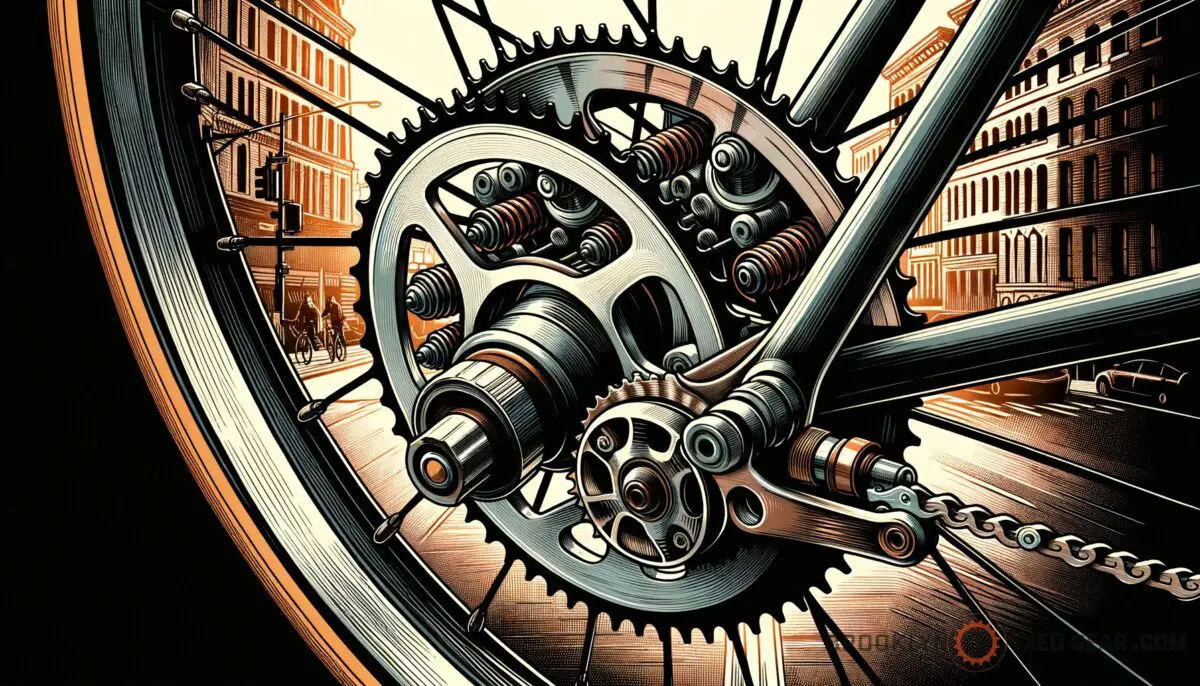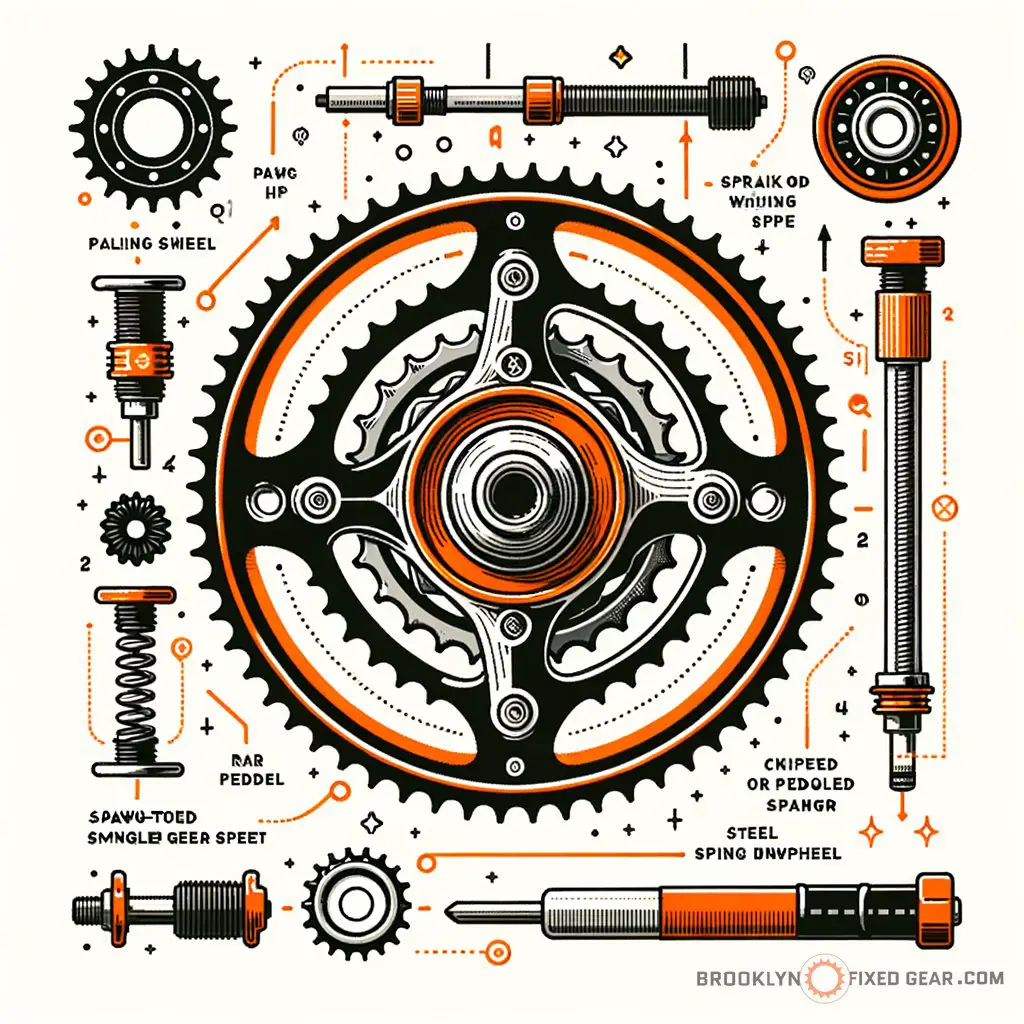Ever wondered how you can glide smoothly without pedaling as you coast down the streets of New York? What exactly is a freewheel, and why is it essential in the cycling world? Check out the best fixie bikes that promise a sleek, freewheeling experience.
You’ll discover the mechanics behind this nifty cycling component that keeps your ride smooth even when your feet take a break from the pedals.
Key takeaways
- Freewheels allow coasting without pedaling and contribute to a seamless riding experience.
- Maintenance is key to the longevity and functionality of your freewheel.
- Understanding the difference between freewheels and cassettes can save cyclists money and time.
What is a freewheel?
A freewheel is like the unsung ninja of your bike, allowing you to take breaks without coming to a standstill. It’s a hub component that lets the rear wheel spin freely when you’re not pedaling, making your ride feel seamless and less taxing.

Here’s a quick rundown of the freewheel’s function:
- Allows the wheel to rotate without engaging the pedals
- Engages the drive when you pedal forward
- Produces a clickable sound when coasting due to the ratchet mechanism
In essence, it’s a clutch for your bike, separating the pedaling motion from the wheel, giving you the liberty to coast. This marvel of cycling tech comes in various designs, from saw-toothed, spring-loaded discs to sophisticated steel rollers—all with the same goal: make your ride smoother.
The mechanics are straightforward yet clever. When you push on the pedals, the freewheel’s teeth or pawls lock in, turning the wheel. Ease off, and it smoothly disengages, letting the wheel spin independently.
This bit of ingenuity is pivotal for those moments when you want to relax your legs without slowing down—a feature central to the fixed-gear experience.
From the original ratchet mechanism to modern iterations, the freewheel has evolved to enhance efficiency and safety. It’s a key component not only for casual riding but also for ensuring precision and control during high-performance events.
Now, this is just my two cents, but having heard countless stories from fellow cyclists and personal moments of gratitude for this simple yet brilliant invention, I think a freewheel’s value is usually underrated. Remember that scene in “Breaking Away” when Dave Stoller’s Dad is bewildered by his son’s freewheel-generated coasting? It’s kind of like that moment for all of us when we realize there’s this intricate piece allowing our wheels to keep on rolling, even as our legs take a breather.
When I think about it, a freewheel is more than just a component; it’s a little taste of freedom. Just the other day, a buddy of mine was telling me about an epic descent where he could just soak in the scenery thanks to the trusty freewheel. If that isn’t a persuasive enough reason to appreciate this nifty gadget, I don’t know what is.
Check out tips on fixing stuff when riding with a freewheel over here.
State Bicycle Co. Black Label 6061

State Bicycle Co. Black Label 6061
Freewheel mechanics
The freewheel mechanism is integral to the cycling experience, especially when it comes to fixed-gear bikes. At its core, it allows for a separation between the driving force and the driven component—a necessity for smooth, effortless coasting.
How does a freewheel work?
The simplest freewheel design includes saw-toothed, spring-loaded discs that engage while pedaling. When the rider stops pedaling, these discs allow the wheel to continue spinning independently. This is accompanied by the clicking noise familiar to cyclists.

Advanced freewheels use rollers for greater durability and are commonplace in the hubs of most modern bicycles.
What benefits do freewheels provide?
Freewheels offer advantages like less wear on the manual clutch and better fuel economy for vehicles using them. They also facilitate gear shifting without the need to depress the clutch pedal in manual gearboxes. However, they can increase brake wear due to reduced engine braking capabilities.
Varieties and uses of the freewheel
Though usually associated with bicycles, freewheel mechanisms are utilized in widespread applications across various modes of transportation and machinery, owing to their clutch-like behavior.
Vehicle transmissions and agricultural equipment
In vehicle transmissions, particularly within specific two-stroke engines and early luxury cars, freewheels serve to reduce engine noise and oil consumption. They’re also crucial in agricultural equipment where they improve safety by preventing tractors from moving when they shouldn’t.
Other applications of freewheels
Freewheels are equally critical in engine starters, preventing damage if the engine back-drives the starter motor. Even helicopters employ freewheels, ensuring the rotor blades can continue spinning independently from the engine during an emergency.
Freewheel vs Freehub: Understanding the difference
With freewheels and cassettes usually confused, knowing the distinction can save you time and money when it comes to maintenance and replacement.
What distinguishes a freewheel from a cassette freehub?
Freewheels screw onto the hub, acting as a single unit, whereas cassette sprockets slide onto a freehub and are held by a lockring. This subtle difference can impact compatibility and replacement across different bicycle designs.
Identifying a freewheel vs a freehub
Visual cues can help determine what system a bicycle uses. Freewheels generally have recessed axles, while cassettes are flush with the gear’s face. Understanding these distinctions is critical for proper bicycle maintenance.
History of the freewheel
Tracing the freewheel’s origins provides insight into its current widespread use in cycling culture and beyond.
The invention of the freewheel
William Van Anden pioneered the freewheel mechanism in 1869, facilitating a non-stop pedaling motion on bicycles. This invention went through early skepticism to global acceptance and integration into bicycles worldwide.
The evolution of the freewheel
From single-speed options to complex gears, the freewheel has seen numerous enhancements. Innovations like the introduction of derailleurs and variable gear ratios have all hinged on the freewheel, illustrating its fundamental role in cycling development.
Freewheel maintenance and troubleshooting
Regular upkeep and knowing how to troubleshoot can prolong the life of a freewheel, ensuring sustained performance.

Tips for caring for your freewheel
Routine maintenance and understanding common issues, like jamming or wear, can keep a freewheel in good working condition. Cleanliness and lubrication are crucial for preserving its mechanism.
Common issues and solutions
Recognizing symptoms like noise alterations or resistance during coasting can indicate freewheel problems. Addressing these promptly can save costly repairs or replacements.
Before we dive into the practical applications and distinctions of freewheels, it’s vital to have a clear understanding of their specifications and variations. Below is a data table that summarises the key aspects of different freewheel mechanisms, their applications, and characteristics.
| Freewheel Type | Description | Common Uses | Notable Features |
|---|---|---|---|
| Spring-Loaded Disc | Simple saw-tooth design that locks during pedaling and releases when not. | Early bicycles, entry-level bikes | Inexpensive, easily replaceable |
| Steel Roller Freewheel | Uses steel rollers inside a cylinder, more durable than disc system. | Higher-end bicycles | Suitable for heavy-duty use, less prone to slipping |
| Pawl Freewheel | Internally toothed drum with hardened steel pawls. | Most modern bicycles | Greater reliability and performance, multiple pawls |
| Overrunning Clutch | Disengages driveshaft when driven shaft rotates faster. | Vehicles, agricultural equipment | Protects against damage from sudden load changes |
| Combined Freewheel System | Luxury cars used them to reduce engine noise and oil consumption. | Early luxury vehicles, classic cars | A smooth, quiet ride with improved fuel efficiency |
| Helicopters | Enables rotor blades to spin faster than its drive engines. | Rotorcraft | Essential for emergency situations like engine failure |
“A freewheel is like the unsung ninja of your bike, allowing you to take breaks without coming to a standstill. It’s a clutch for your bike, separating the pedaling motion from the wheel, giving you the liberty to coast.”
When it comes to freewheel maintenance and use, there are certain best practices you’ll want to follow to ensure your ride stays smooth and safe. These tips can mean the difference between a flawless glide and a fixie fiasco. Here’s a table of dos and don’ts to help you get the most out of your freewheeling experience.
| Do | Don’t |
|---|---|
| Regularly clean and lubricate your freewheel | Neglect strange noises or resistance |
| Check for wear and replace when necessary | Force a stuck freewheel to turn |
| Use the correct tools for installation | Over-tighten the freewheel onto the hub |
| Gently pedal when shifting gears | Ignore proper lockring tightening |
| Keep an eye on the alignment | Use a freewheel not designed for your bike |
More cycling tips
Whether you’re street cruising or hitting the velodrome, cycling is as much about technique as it is about the gear. Beyond just knowing your freewheel, here’s a list of pointers aimed at enhancing your overall cycling experience:
- Always wear a helmet; safety is paramount and non-negotiable.
- Invest in a quality bike multi-tool for on-the-go adjustments and repairs. It’s a lifesaver when you need to tweak something miles from home.
- Develop a fluid pedaling technique to maximize efficiency and reduce strain on the knees.
- Learn the essentials of drafting to conserve energy during group rides or races.
- Regularly check your tire pressure to ensure optimal performance and comfort. Too low, and you risk a pinch flat; too high, and your ride gets unnecessarily harsh.
- Explore different handlebar types to find the most comfortable and aerodynamic position for your riding style. Maybe drop bars will be your calling for that speedier posture.
If you are a visual learner, check out this video titled ‘Difference Between Cassette vs. Freewheel’
Frequently asked questions (FAQ)
Can a freewheel be repaired if it starts slipping?
Once a freewheel starts slipping, it’s usually a sign that the internal mechanism is worn out. While some minor issues can be temporarily fixed with adjustments and lubrication, a slipping freewheel usually requires a replacement to ensure reliable performance and safety.
Does the type of freewheel affect my bike’s speed?
The type of freewheel itself doesn’t directly affect the speed of your bike; however, smoother and more efficient mechanisms can enhance riding experience and indirectly contribute to better speed by allowing for smoother transitions and less energy loss when coasting.
Is it possible to retrofit a freewheel onto any kind of bike?
Not all bikes are designed to accommodate a freewheel, as some are specifically built for fixed-gear setups. However, many threaded hubs can accept a freewheel mechanism. It’s crucial to ensure compatibility with the bike’s hub and the intended type of riding before attempting to retrofit a freewheel.
Final thoughts
In conclusion, the freewheel is an innovative and essential component of the cycling world, making your rides effortless and enjoyable. Whether you ride a classic fixie or a modern bike, understanding the freewheel can help you keep your bike in top condition and enhance your riding experience. Remember, a well-maintained freewheel means more freedom on the road and fewer worries about unexpected bike maintenance.
What’s your experience with freewheels? Have they transformed your cycling experience as much as they have for others?Did I cover everything you wanted to know? Let me know in the comments section below—I read and reply to every comment. If you found this article helpful, share it with a friend, and check out my full blog for more tips and tricks on freewheels and cycling. Thanks for reading, and keep on rolling!















